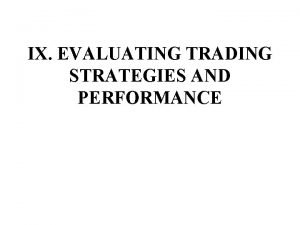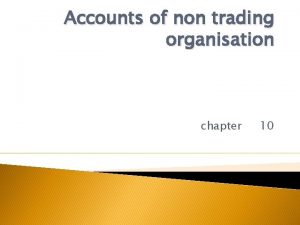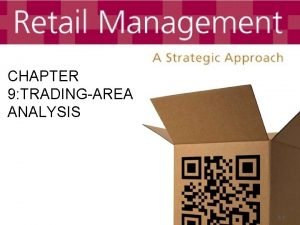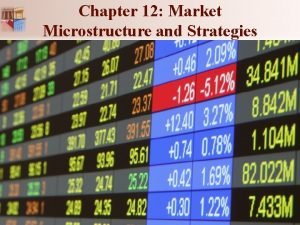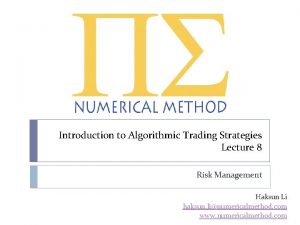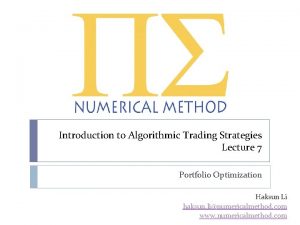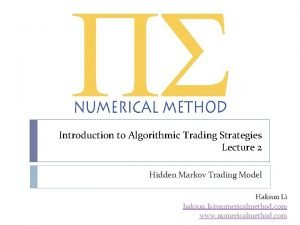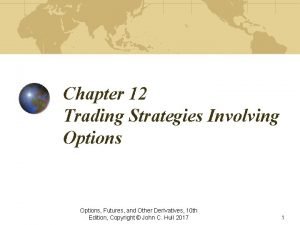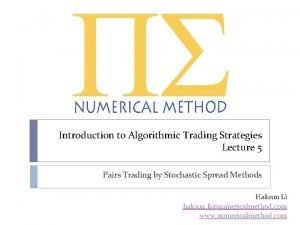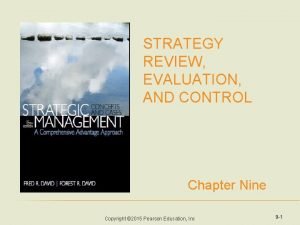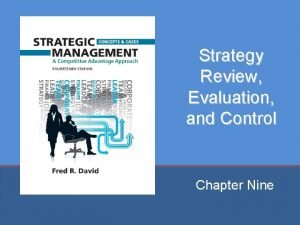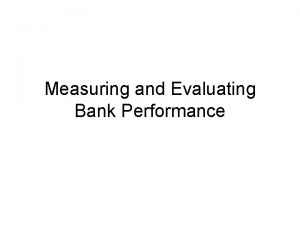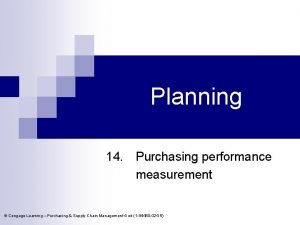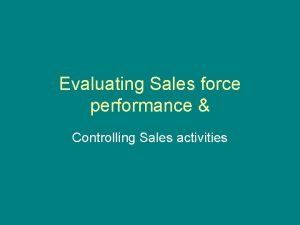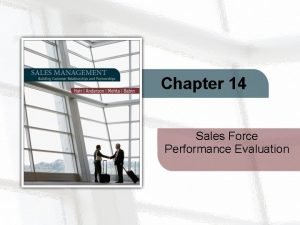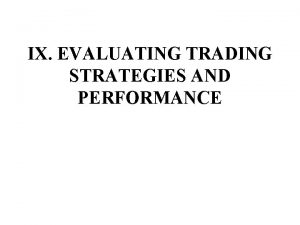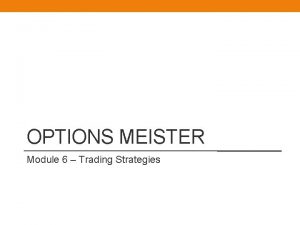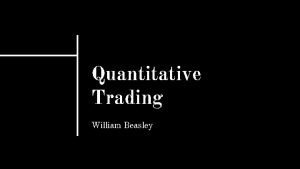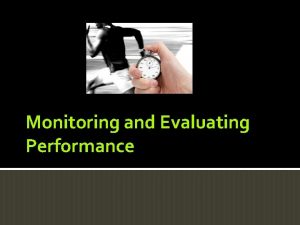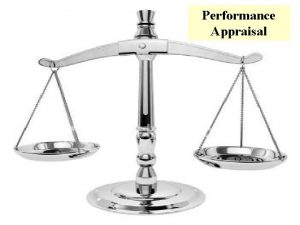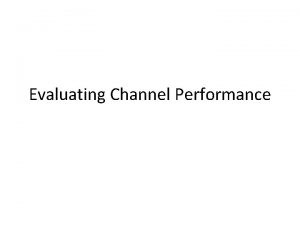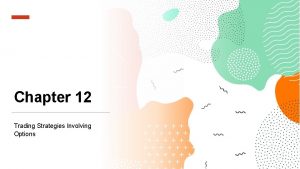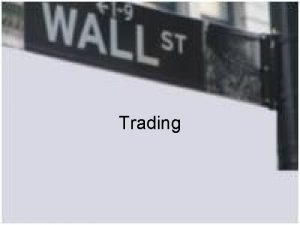IX EVALUATING TRADING STRATEGIES AND PERFORMANCE A Evaluating














- Slides: 14

IX. EVALUATING TRADING STRATEGIES AND PERFORMANCE

A. Evaluating Investment Portfolio Performance • One standard for comparison is the simple buy and hold into a diversified portfolio strategy • Fund net asset value (NAVt) and returns (including the time weighted average return) are computed as follows:

Illustration: NAV and Returns

Portfolio Benchmarking • Higher returns are generally associated with higher risk, such that appropriate benchmarking is important. Sharpe Ratio Treynor Ratio Jensen Measure: Jp = [rp - rf]-[ p(rm-rf)]

Benchmarking Difficulties The following represent additional issues for investment institutions regarding the difficulties of using the above risk adjusted portfolio performance measures: • • • Given that portfolio managers change jobs rather frequently, is it reasonable to measure fund performance rather than manager performance? How frequently are we able to obtain enough data to obtain statistically significant measures of performance? The Capital Asset Pricing Model (CAPM), a model that decomposes return into compensation for time value of money and compensation for risk, serves as the basis for the Treynor and Jensen Measures: The CAPM: E[rp] = rf + [ p(rm - rf)] where E[rp], rf and rm are the expected return on the portfolio, the riskless Treasury bill and the market as a whole. However, the CAPM is only a single time period model. Multiple time periods and multiple cash flows cause problems in its application. In addition, many analysts will be concerned about the many assumptions that underlie the CAPM, as well as certain statistical tests that cast doubt on the empirical validity of the CAPM. Investors holding funds representing only market segments might find that any measure based on the Capital Asset Pricing Model is inappropriate. The Sharpe Ratio will understate portfolio performance of undiversified portfolios in a setting where investors, in sum, hold numerous undiversified portfolios. That is, much of the risk captured in the Sharpe Ratio can be diversified away. Errors in computing returns will bias measured betas downwards and will "slop" over into unsystematic variances (the part of risk that is unrelated to the market). Even seemingly minor problems can significantly bias beta measures. However, there do exist reasonably good correction procedures for betas measured with error.

Portfolio Performance Benchmarking Illustration • The following are portfolio and market returns over a 20 -year period:

B. Market Timing versus Selection • The Quadratic Variable Approach

The Dummy Variable Approach • rq, t - rf, t = αq + βq(rm, t-rf, t) + γq. D(rm, t-rf, t) + et • where: If (rmt-rft) ≥ 0, D = 0 • If (rmt-rft) < 0, D = 1

C. Trade Evaluation and VWAP • VWAP (Volume Weighted Average Price is calculated by dividing the dollar volume of trading in a stock by the share volume over a given period of time, typically one day. • Arrival Price: The midpoint of the bid-offer spread at the time the order is received (Bid-Ask Midpoint or BAM). • MOC (Market-on-close): the last price obtained by a trader at the end of the day relative to the last price reported by the exchange. • Implementation shortfall: the performance difference between the hypothetical profits realized by a paper or theoretical portfolio replicating an actual portfolio ignoring friction costs and the profits realized by the actual portfolio.

VWAP • VWAP can be used as a benchmark to evaluate the quality of the execution provided by the broker. • If the brokerage firm’s purchases were made at a lower VWAP than the market VWAP for the relevant period, the firm handled the order well for the customer. • VWAP, either for the trader or for the market is calculated as follows:

VWAP: A Simple Illustration • • Suppose that a broker has been instructed to purchase 600 shares at the market. She does so, purchasing them for a total price of 30, 011. The broker's executed transactions were the second through fourth transactions on the table. The total volume of shares exchanged was 2, 500, with a total value of 125, 098. Hence, VWAP for these transactions was 125, 098/2, 500 = 50. 0392. The broker purchased 200 shares in the first transaction at 50. 01 and 400 shares in the third transaction at 50. 02. The average share price paid by the broker was 30, 010/600 = 50. 0167. Our calculations suggest that the broker beat the market VWAP.

D. Implementation Shortfall The implementation of an investment strategy by the trader or portfolio manager leads to four primary types of friction costs: • Broker, exchange and other explicit fees and commissions. Frequently, brokers bundle exchange, SEC and other fees into their own commissions. Small transactions tend to have higher proportional explicit transactions costs. • Delay costs, based on the price difference between the portfolio manager’s decision price and the broker’s arrival price • Price impact costs associated with transaction executions (slippage). Buy orders will exert upward price pressure on the security; sell orders will exert downward pressure. Larger transactions will tend to have larger impact costs. • Opportunity costs associated with transactions; that is, the opportunities and profits were forgone prior to the trade’s completed execution. Opportunity costs can also include the portion of an order that was canceled due to a limit order restriction.

Implementation Shortfall Illustration • • • Suppose that a portfolio manager makes a decision to purchase 10, 000 shares of stock one hour before its open based on its $50. 00 closing price the prior day (the decision price) and a limit order at 50. 45. The stock opened at 9: 30 at a price of 50. 20, and 1000 shares are purchased at 9: 31 at a price of 50. 25. At 9: 32, 5000 shares are purchased for 50. 40, and 1000 more for 50. 30 at 10: 03. An additional 1000 shares are purchased for 50. 30 at 12: 15, the market price quickly rises to 50. 48 and closes at 50. 50 with 2000 shares in the order unexecuted. The commissions, including all explicit fees were $0. 01 for each of 8, 000 shares.

E. Value at Risk • Value at risk (Va. R) measures the worst loss for a given time frame, with a given set of distributional assumptions at a given confidence level. • Suppose that a trader has "borrowed" $900, 000 from his employer and invested $100, 000. This trader's employer requires that the trader's one-week portfolio Va. R not exceed his trading capital of $100, 000, with a 99% degree of confidence. i wi i 1, i 2, i 3, i 1. 20. 04 . 01. 02 2. 50. 40. 01 . 16. 04 3. 30. 60 . 02 . 04 . 36
 Evaluating trading strategy
Evaluating trading strategy Non trading organisation
Non trading organisation Methods of evaluating trading area
Methods of evaluating trading area Market microstructure trading strategies
Market microstructure trading strategies Introduction to algorithmic trading strategies
Introduction to algorithmic trading strategies Introduction to algorithmic trading strategies
Introduction to algorithmic trading strategies Introduction to algorithmic trading strategies
Introduction to algorithmic trading strategies Trading strategies involving options
Trading strategies involving options Introduction to algorithmic trading strategies
Introduction to algorithmic trading strategies Rumelt's criteria for evaluating strategies example
Rumelt's criteria for evaluating strategies example Rumelt's criteria
Rumelt's criteria Evaluating bank performance
Evaluating bank performance Purchasing performance evaluation
Purchasing performance evaluation Evaluating sales performance
Evaluating sales performance Sales force performance
Sales force performance
